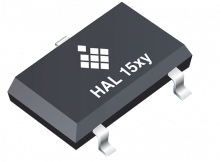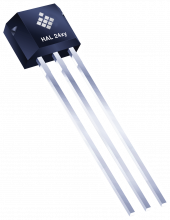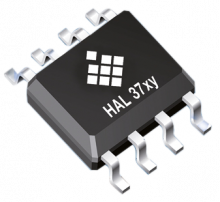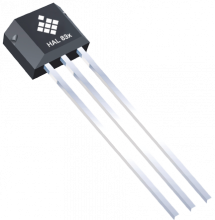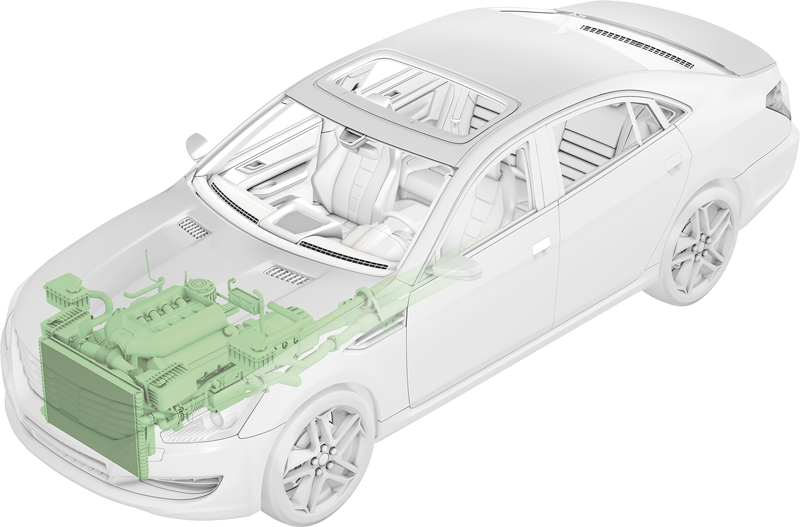

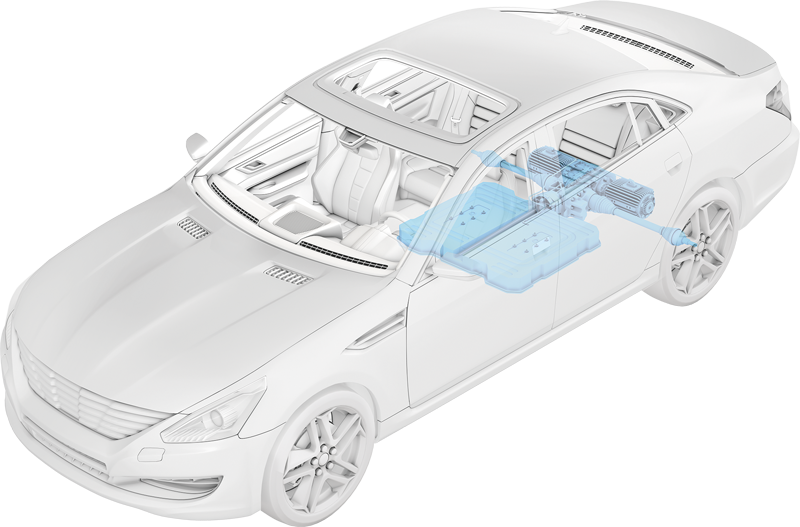
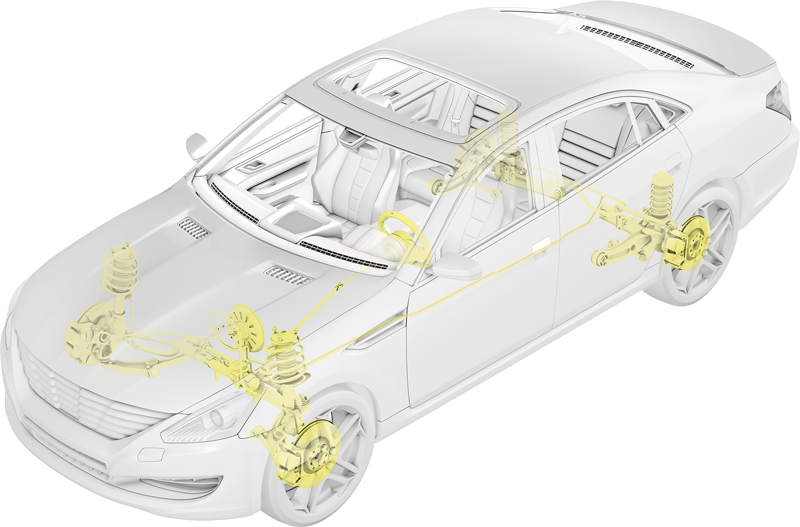
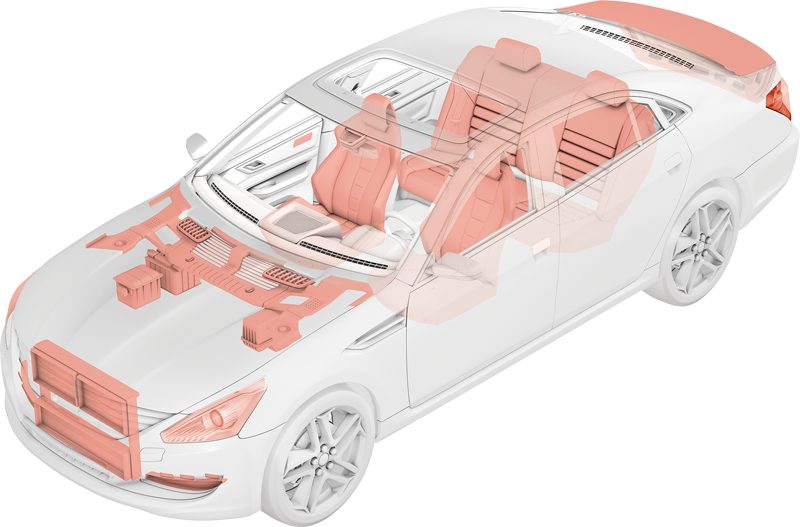
Active Pedal - Clutch
To improve safety, comfort, and responsiveness, modern systems like cruise control systems, electrical parking brake, start-stop functions, start lock and torque adjustment require a displacement sensor on the clutch master cylinder. The displacement sensor measures up to 40 mm travel. 2D Hall-effect sensors are a robust and cost-effective solution for this task. They bring reliability and high accuracy together with low air gap and temperature sensitivity. Additionally, EV and HEV drive the need for stray-field robustness addressed by HAL 3930.
Sensor Type: 2D
Products inside:
Active Pedal - Acceleration
The Acceleration Pedal Sensor (APS) converts the driver‘s accelerator pedal effort into an electric signal and sends it to the engine control unit (ECU).
Two APS signals are checked for range and plausibility. The two sensors are completely independent, each one is supplied with a separate reference voltage (full redundancy). If one sensor fails, the other is used as a "limp-home" input, so the ECU will limit the maximum engine speed.
Linear Hall sensors with analog output are used to detect pedal courses with small angle (<20°). They bring reliability and high accuracy, especially to detect the accelerator idle position. They also provide small offset and sensitivity drift over lifetime and temperature.
Additionally, EV and HEV drive the need for stray-field robustness. Furthermore, an ISO 26262 compliant device is mandatory. Both requirements can be addressed by HAL 3930.
Sensor Type: 1D, 2D
Products inside:
Powertrain Valves - Throttle
In a gasoline internal combustion engine, the throttle is a valve that directly regulates the amount of air entering the engine, indirectly controlling the charge (fuel + air) burned on each cycle due to the fuel injector or carburetor maintaining a relatively constant fuel/air ratio.
In a diesel engine, the throttle is used to generate intake manifold vacuum.
Linear or 2D Hall sensors with analog output are used to detect the throttle position. They bring reliability and high accuracy together with small offset and sensitivity drift over lifetime and temperature
Sensor Type: 1D, 2D
Products inside:
Powertrain Valves - EGR
In internal combustion engines, exhaust gas recirculation (EGR) is a nitrogen oxide (NOx) emission reduction technique used in petrol/gasoline and diesel engines. EGR works by recirculating a portion of an engine’s exhaust gas back to the engine cylinders. Exhaust gas is routed back into the combustion chamber because the exhausted air is much hotter than the intake air. By sending warmer gas into the combustion chamber, the air/fuel mix does not have to do as much work to heat up and the engine can run more efficiently.
EGR valves require the measurement of linear movements in the range of ±12 mm. 2D Hall-effect sensors provide a potential solution for the measurement of the current valve position being robust against air gap and temperature variations. This application is strongly moving to PCB-less designs driven by the temperature range requirements. This requires leaded devices with integrated capacitors.
Additionally, HEV drives the need for stray-field robustness. Furthermore, an ISO 26262 compliant device is mandatory. Both requirements can be addressed by HAL 3930.
Sensor Type: 2D
Controller Type: HVC
Products inside:
Powertrain Valves - Thermal Valves
Small valves are deployed throughout the vehicle for instance for the water cooling circuit control of a combustion engine.
Micronas 2D Hall-effect sensors provide a suitable solution for the measurement of the current valve position being robust against air gap and temperature variations. Additionally, EV and HEV drive the need for stray-field robustness covered by HAL 39xy family.
HVC all-in-one integrated solutions offer a very small footprint while matching the power requirements for a BLDC drive in a single-chip solution without the need for external MOSFETs.
Especially the trend for integrated systems is driving the need of digital interfaces like SPI. HAL 3900 together with HVC enable the customer to provide thermal management systems with high integration.
Sensor Type: 2D
Controller Type: HVC
Products inside:
Battery Management
A high-precision current sensor is required for Battery Management System structuring SOC (State of Charge) and SOH (State of Health) estimation. TMR- and Hall-based magnetic-field sensors enable current measurements with high sensitivity and high accuracy in high-power applications with low output voltage drifts over temperature and a multiple magnetic-field range. The galvanically isolated power and sensing circuits are of particular benefit in 12/48 V battery monitoring and start-stop systems.
Sensor Type: Current Sensor, 1D
Products inside:
Gear position
Commonly located inside the automatic transmission, the gear position sensor communicates the gear position to the vehicle’s electrical system.
A combination of several linear Hall sensors (up to six) is deployed in each transmission. Recent developments use 2D position sensors as well. Analog or PWM output is required. Linearization setpoints are needed depending on the travel distance to measure. Functional safety requirements drive the need for digital output formats like SENT.
Sensor Type: 1D, 2D, TMR
Products inside:
Water / oil pumps - BLDC Motor
Hall switches or TMR angle sensors are used to detect the rotor position for any type of pumps using a brushless DC motor (BLDC). To reduce the overall current consumption, the HAL 15xy 3-wire version with only 1.6 mA is preferred.
TMR sensors are located at end of shaft and provide a very high signal resolution and stability over temperature and can operate at very high speed.
HVC products are very well suited to provide an efficient BLDC drive for auxiliary pumps.
Sensor Type: Switch, TMR
Controller Type: HVC
Products inside:
Liquid Level
Hall sensors are used to detect the liquid level (e.g. brake fluid) in a tank. Linearization setpoints are required here.
Sensor Type: 1D, 3D
Products inside:
Shift Lever Position
Hall sensors are used to determine the current position of the gear shift lever. The application setup can be realized by different solutions: from simple rotary shifters up to joystick-type based solutions. Both setups require a 2D (rotary) or 3D (joystick or rotary with push-function) position detection.
Hall switches are used for extremely price-attractive solutions by placing several switches at each gear position.
Sensor Type: 3D, Switch
Products inside:
Turbo charger
The use of pressure charging to improve engine efficiency and therefore fuel economy within the normal range of driving conditions is becoming more and more popular.
Magnetic-field sensors with analog output and SENT interface are used to detect the vane position which blocks or increases the air flow to the turbine. Hall sensors bring reliability and high accuracy together with low offset and sensitivity drift over lifetime and temperature.
This application is strongly moving to PCB-less designs driven by temperature range requirements. This requires leaded devices with integrated capacitors.
Additionally, EV and HEV drive the need for stray-field robustness. This requirement can be addressed by HAL 3930.
Sensor Type: 1D, 2D
Products inside:
Combustion Engine
An increased demand for high energy efficiency and CO2 reduction asks for optimized sensor and actuator solutions. TDK aims to provide solutions for all applications in a conventional car from battery management to exhaust valves through shift lever and pedal position sensors. TDK develops high-accuracy sensors designed to withstand harsh under-the-hood environments: insensitive to vibrations, temperature drifts and dirt.

